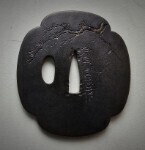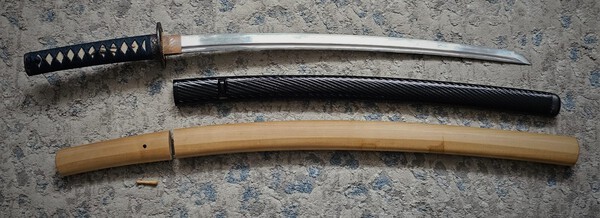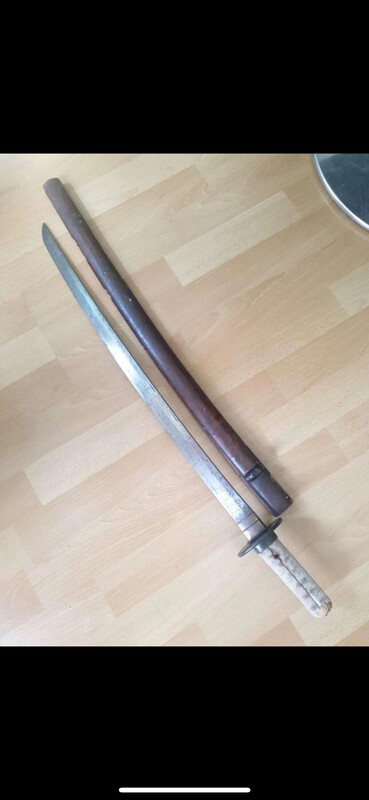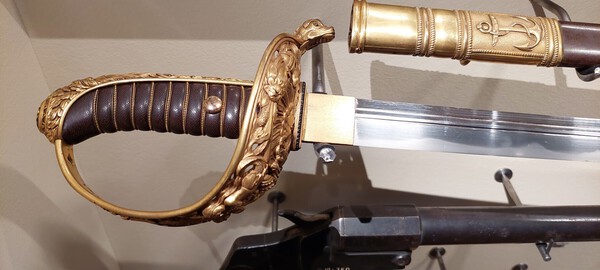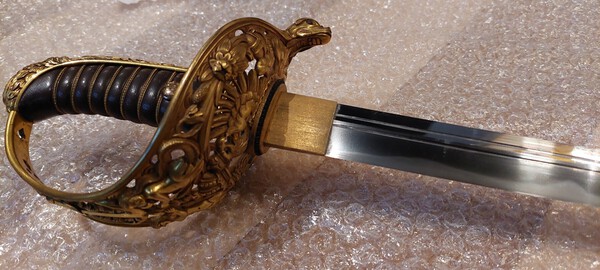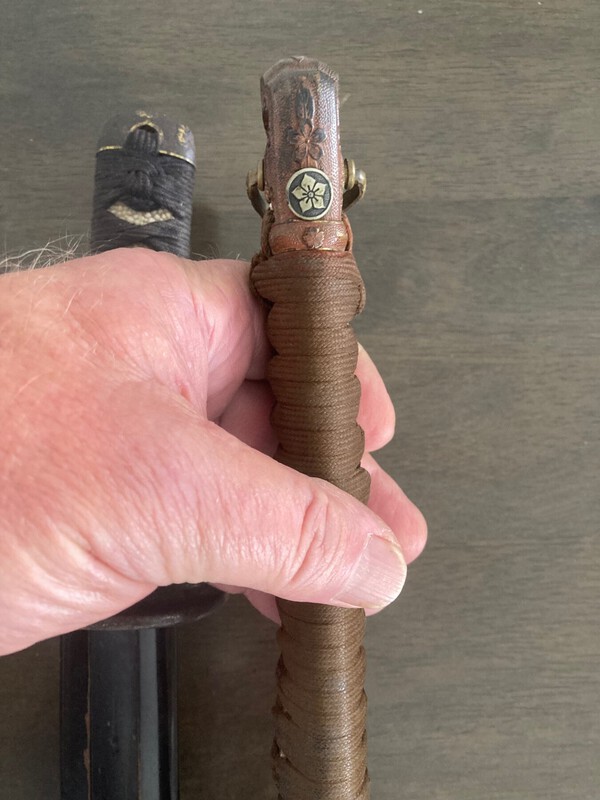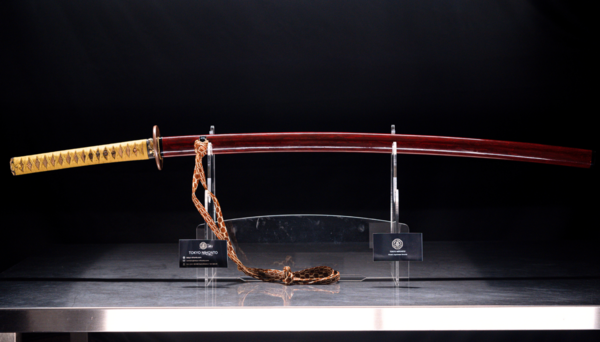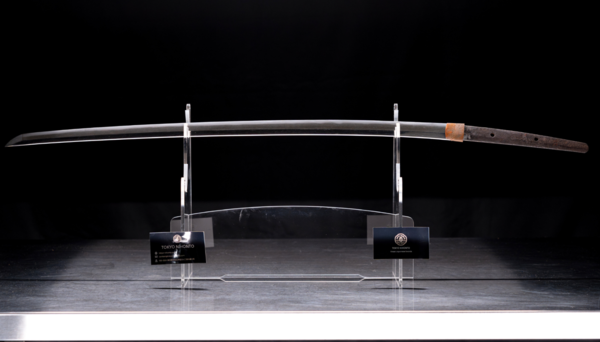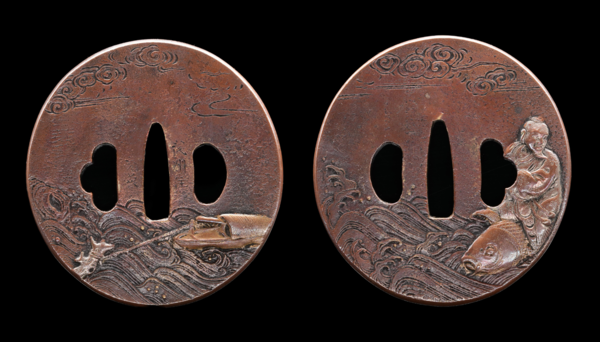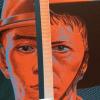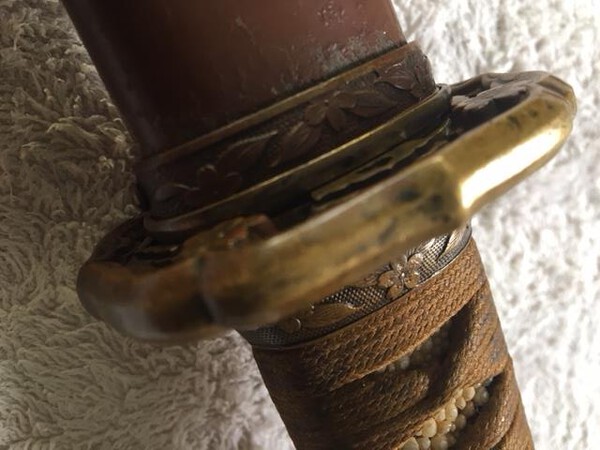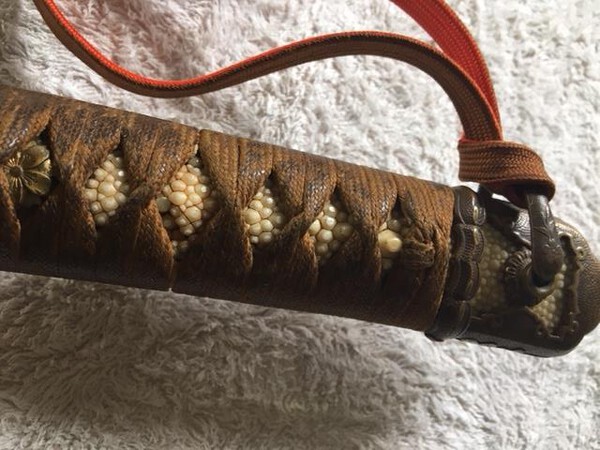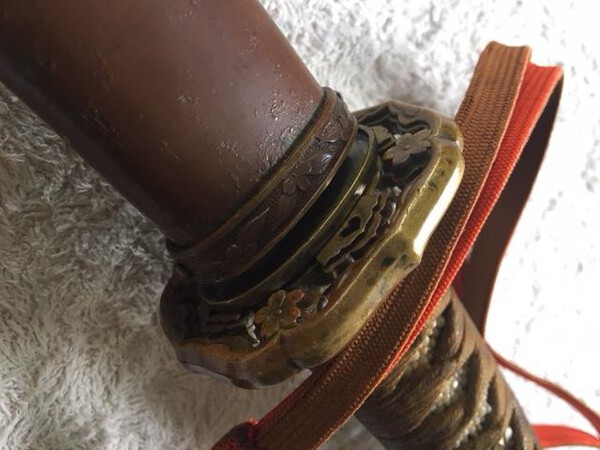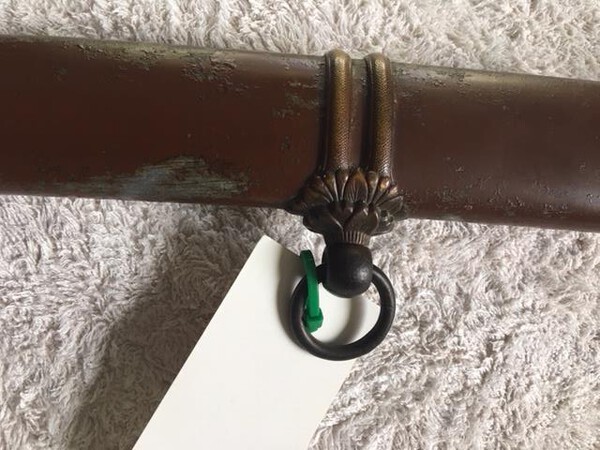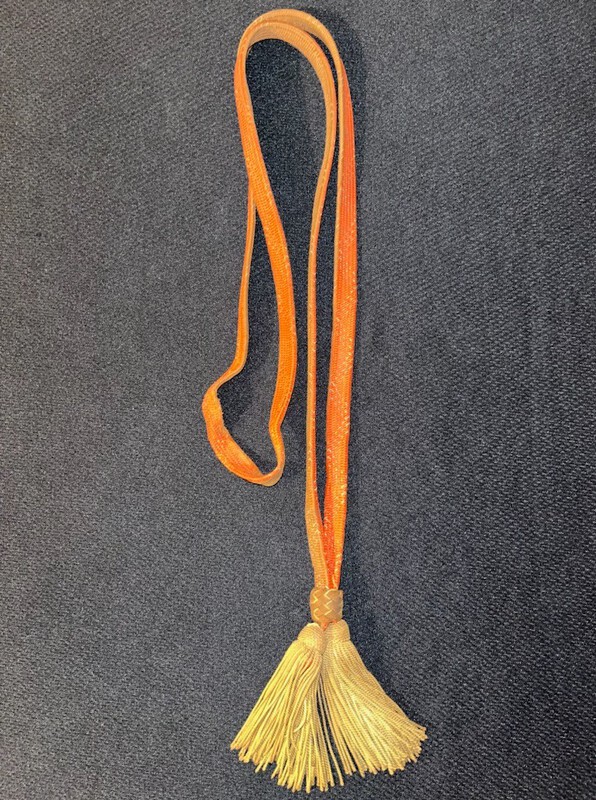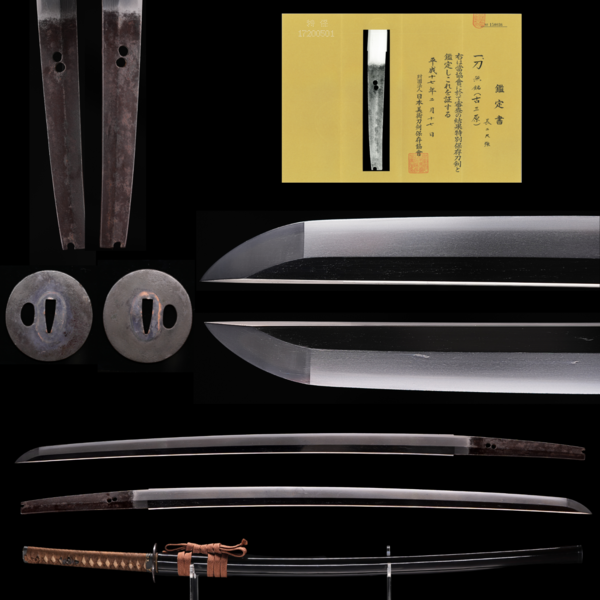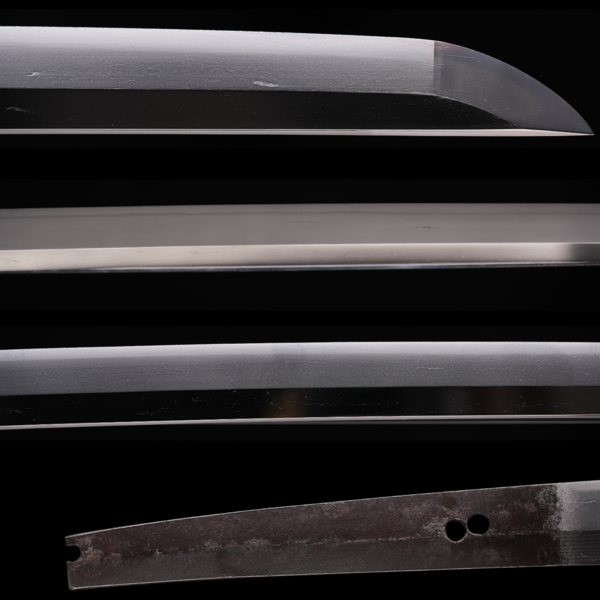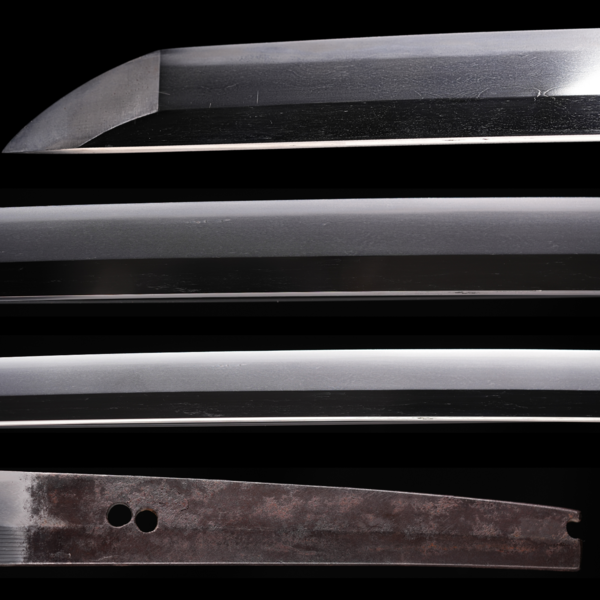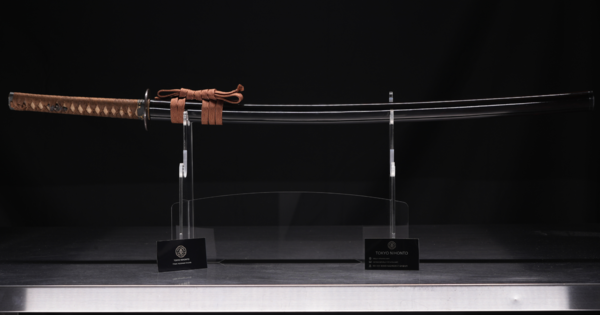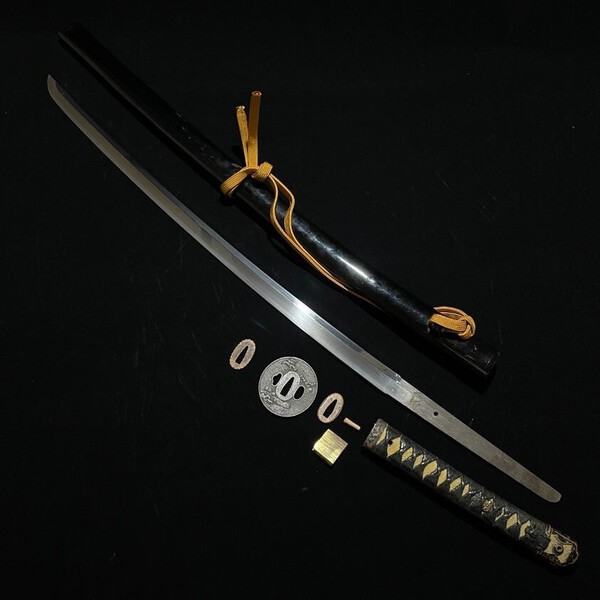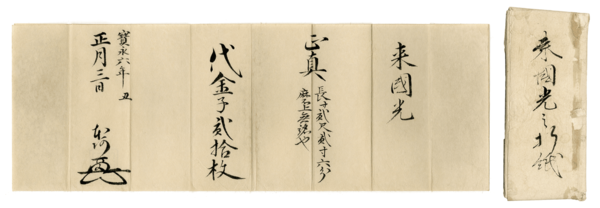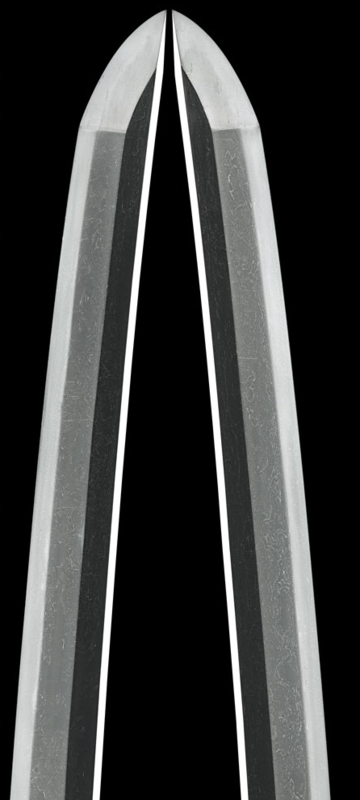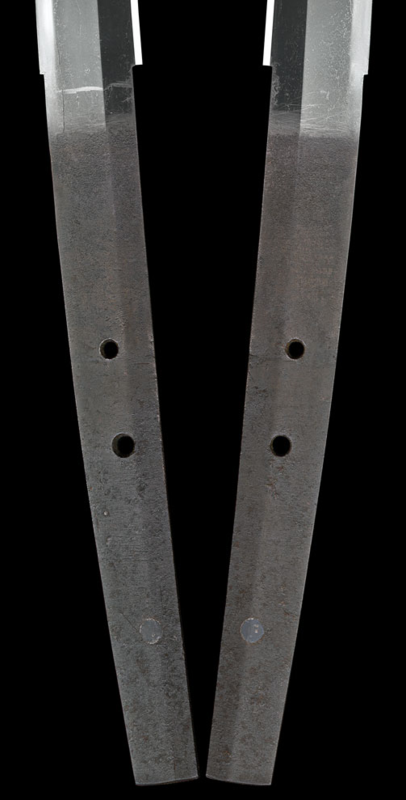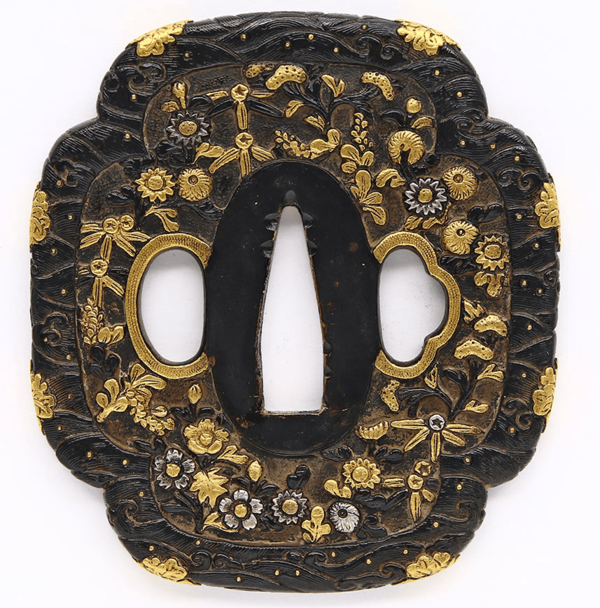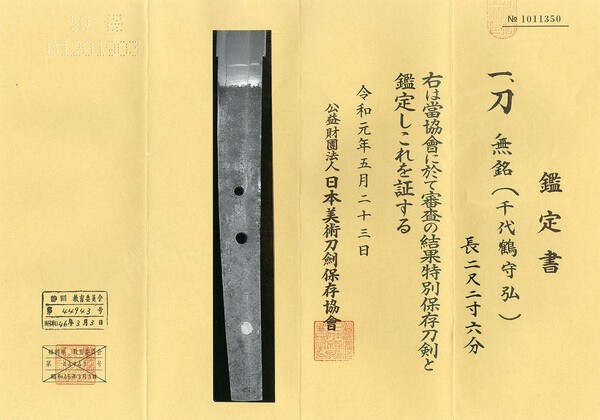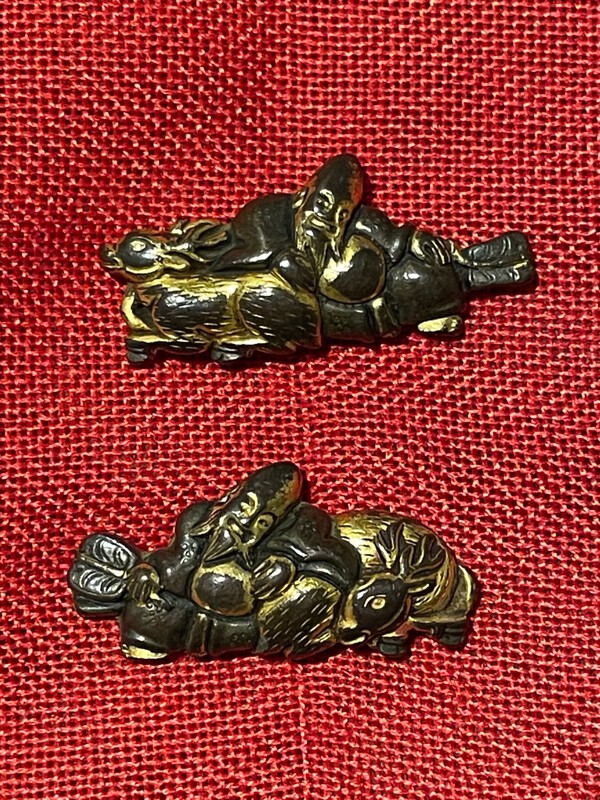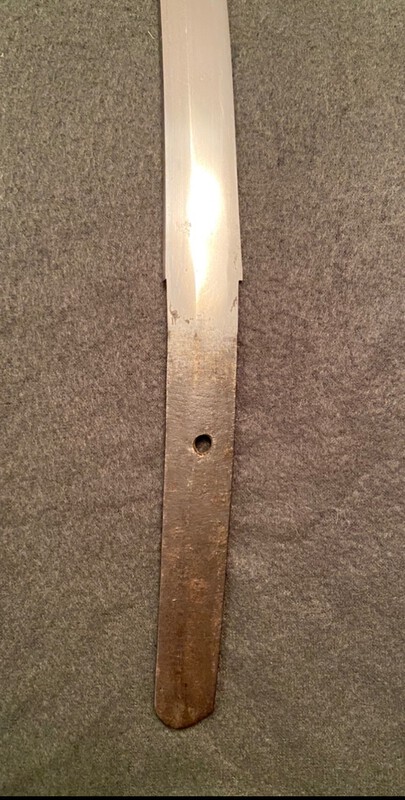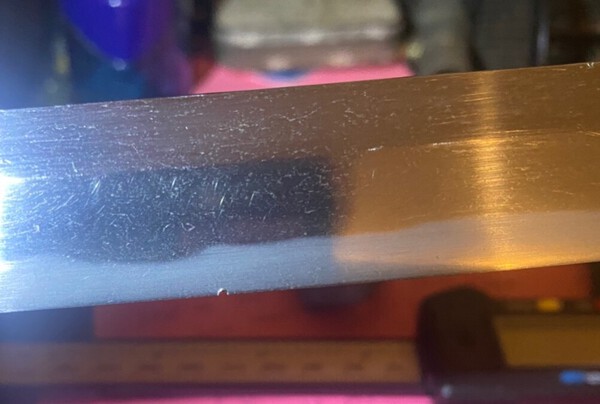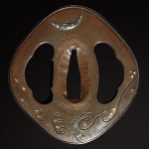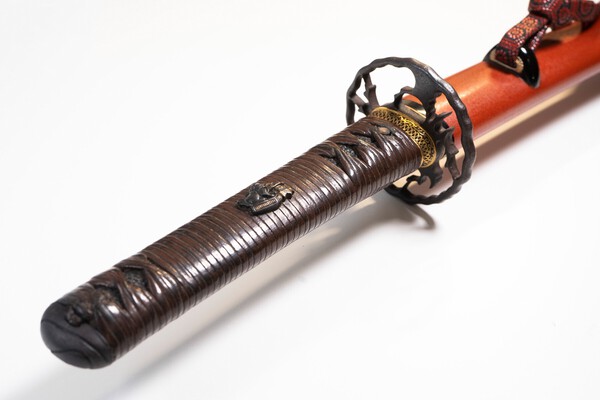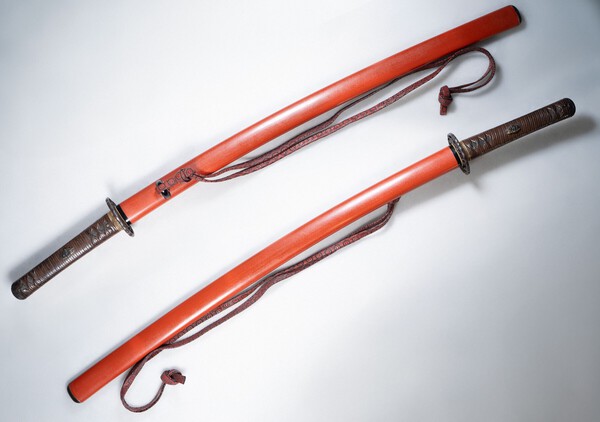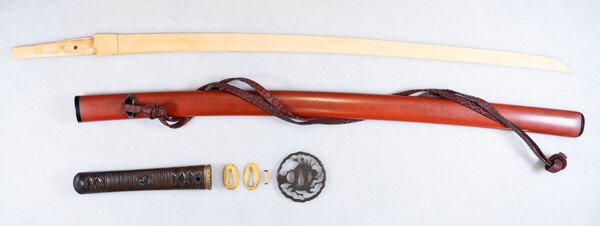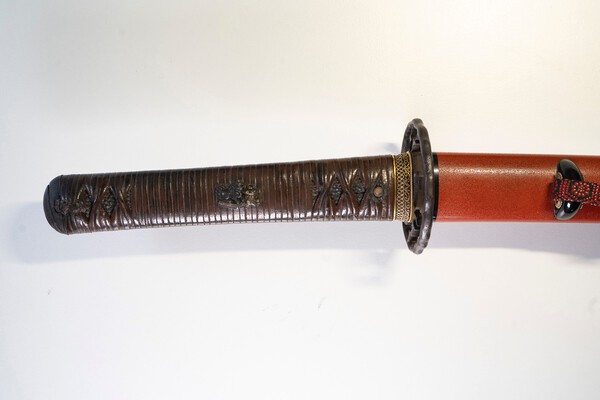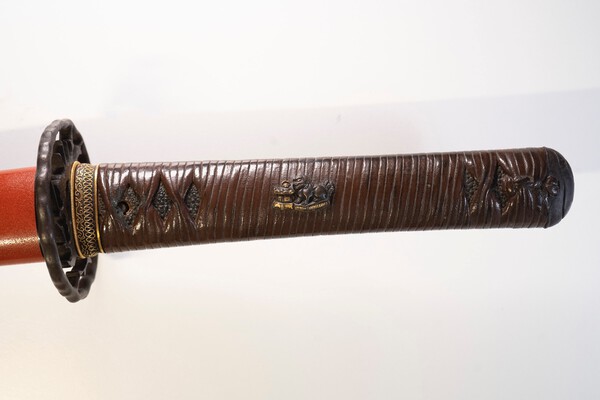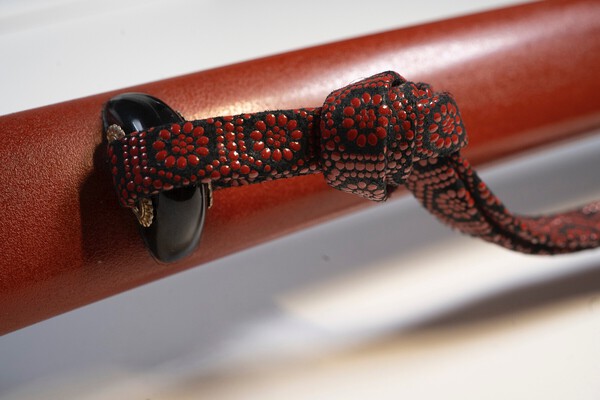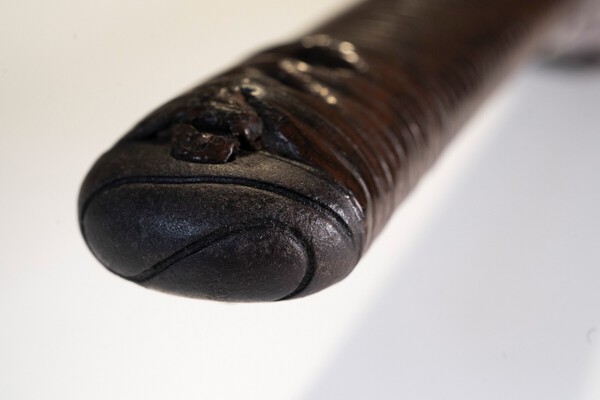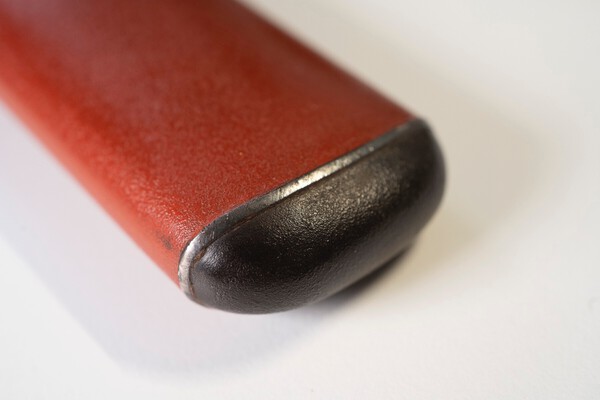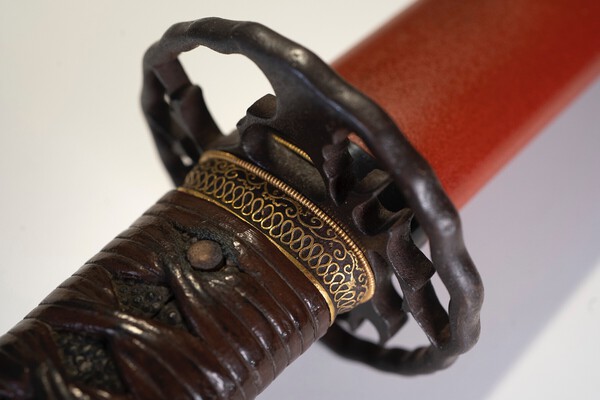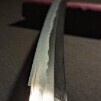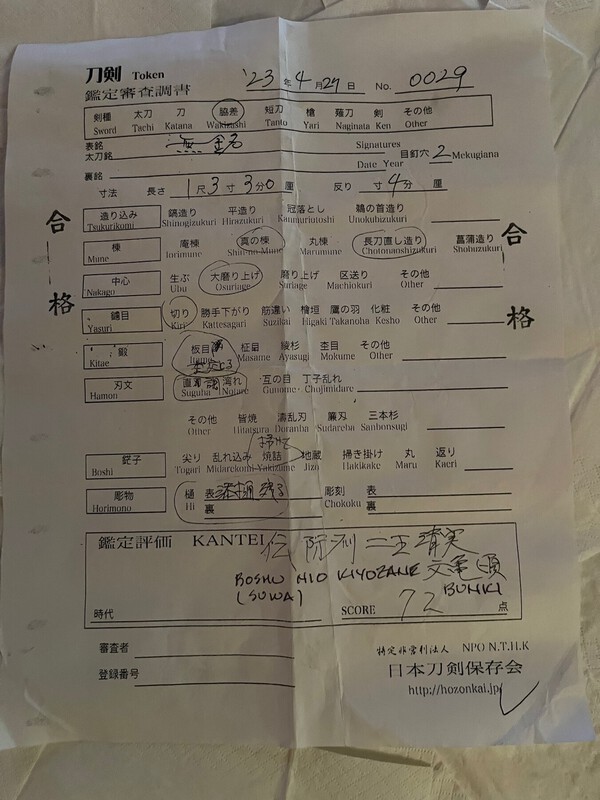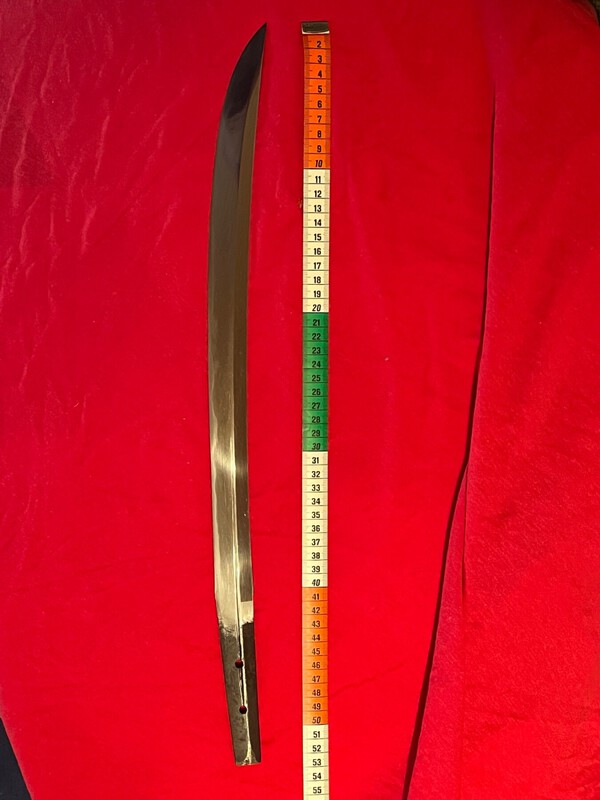Search the Community
Showing results for tags 'koshirae'.
-
Type: Wakizashi Ubu, Suriage or O-Suriage : Ubu Mei : (Mumei, Signature) : Bizen Ju (?Mitsu?) Papered or not and by whom? : Not Era/Age : Koto/Muromachi (~1500) Shirasaya, Koshirae or Bare Blade? : Koshirae + Shirasaya Nagasa: 49.7 cm. Sori: 1.5 cm. Moto-haba: 2.7 cm. Saki-haba: 1.7 cm. Moto-gasane: 0.7 cm. Saki-gasane: 0.5 cm. Flaws : Old hadaware fix (please check pictures) Sword Location : Poland EU Will ship to : Anywhere Payment Methods Accepted : Bank2bank wire-transfer (USD) Price and Currency : 2650$ + shipment costs. Other Info and Full Description : Hi, I'm looking to sell my Koto Bizen Osafune Wakizashi. Decent polish and very good (IMHO) overall condition. It comes with beautiful Koshirae (renovated, Fuchi/Kashira/Menuki/Tsuba/Kojiri are from early Edo period). If you are interested, please ask and I will do my best to answer. I can also post additional pictures or videos if needed. My asking price is equal to what I have paid, no earnings here.
-
Hi all, This is from a brand new koshirae. At first I felt that something was off with these shitodome... Didn't know why. Now I realize that it's because I have never seen a rectangular shape shitodome on antique/Japanese made koshirae! Have you?
-
Hello, This summer I am going on a trip to Japan and was intending on bringing back home some sword fittings as souvenirs to display. I have two questions regarding this: 1. Do fittings need to be de-registered or is that just for blades since they're weapons? What about a whole Koshirae with a wooden Tsunagi? 2. Say I buy some fittings (a Tsuba, Menuki and Fuchi/Kashira), and that they are all for the same type/size of sword, with the Fuchi being the right size to cover what it should on the bottom of the Tsuba, is it possible to get a custom Tsuka (non-hollow, as it wouldn't hold a blade) made and wrapped to display the fittings, with a little protruding piece to hold the Tsuba? Has something like this ever been made? Sorry if this is a stupid question. Best regards, Zachary
-
I recently acquired a Japanese Naval Dagger that is missing the brass pommel cap. (Note first image attached). I am looking to purchase a genuine one. It should be a standard size as far as I can tell. An example is shown in the second attachment. Let me know if you happen to have one I could purchase. Thanks, Dave 1104
-
Hi, About a year ago, I started the restoration of the koshirae of a nihonto I bought. The blade the original koshirae was mounted on is nothing special. The price of a polish would exceed the price it would be worth afterwards. Same with a new koshirae. But it was the first nihonto I bought, and I wanted at least to preserve the blade. The original saya and tsuka were cracked and no longer airtight. First I crafted a new tsuka core and then finished the tsuka with new antique fittings because the original kashira was lost. After the tsuka was finished, I bought honoki wood from Namikawa and started carving the saya. After months, the carving and lacquering is finished. I chose an Ishime pattern for the saya, and I think it was not a failure. The Katana kake in the background was also made by me. The next project is building a lightning solution. The current one is only a prototype to test the function. Please ignore the cables. They will be hidden afterwards. One of the pictures is a before-and-after picture, by the way. I hope you like the new koshirae and don't just dislike it, because it was not crafted by a traditionally trained artist. I did the best I can and learned lot on the way. If I were to start again, I think the build would be even better.
- 4 replies
-
- 6
-

-

-

-
- koshirae
- restoration
-
(and 1 more)
Tagged with:
-
Hello everyone! A few months ago, I purchased a Nihontō in koshirae from a consignment sale in Japan (from a “go-between” dealer) and just received export approval from the Cultural Ministry. While I wait for it to arrive, I was hoping to find out a little more about the age and smith. I did try to do my own research before I purchased, feeling pretty confident it was indeed a Nihontō (aside from the fact that I was purchasing from Japan with papers…but you never know). Thanks to another member of the community, I was able to discover it had an nijimei of “兼直”. On the Nihontoclub website, I was able to find a few smiths using this name, but the dates are a bit all over the place. Im not expecting this blade to be from the 1400-1500s (despite being pretty out of polish), but it doesn’t seem like a 1935-1945 blade either…it’s missing a stamp (could be worn off?), and I haven’t seen many Showato with nijimei (though I am also very much a beginner). Also, I’m under the impression that Showato are more than likely not being sold IN Japan, even as exports, but I know that is debated. While the fittings may not be from this blade originally, maybe they’ll help date it? The tsuba looks Edo period based on the shape and style (chrysanthemum and heavily circular shape, but i could be wrong!)… I can take much better pictures when I receive it, but in the meantime, I’d love to get some thoughts here. Thanks!
-
Hi, I bought a Nihonto last year which had a split saya and broken tsuka. The pictures below are how the state was when I bought the sword. I first built a new tsuka from scratch. By the way, I am no woodworker, and this was my first real woodworking project. Later I build a new saya due to the cracked saya, which is not airtight anymore. The wood is honoki wood I bought from Namikawa. Picture below shows the old cracked saya Below is a photo with almost finished koshirae The last step I have to make is to add a Kurikata. I know you normally carve the place for the kurigata out before painting, but the material was too thin to make it that way. The original saya is also very slim, and I made it like the original. I choose to paint it black and still consider making an ishime finish before adding the kurigata. What do you think? The paint is not urushi because it is not really available in my country, and curing it is not possible in my environment (air humidity and temperature). I also built the katana kake in the picture. I hope you like it. Finally, the reason I built a DIY korishae is because the old one is broken, and it would not make sense to get a new one made before it was polished. Because the blade is a mumei and probably not worth the money it would cost to get it polished and get a new koshirae, I made the decision to leave the blade in its unpolished state and just make a new koshirae. The project was really interesting, and I learnt a lot from it. I think it looks good for my level of skill in woodcraft. Please don't hate; just constructive criticism.
-
Hi, I am still new to this forum but i want to share with everyone a unique piece, that is my absolute favorite among our vast collection, from the military history institute museum I work at as restorer/conservator. As the title, possibly somewhat confuzingly states, It is a amalgamation of a Japanese blade and Austrian officer navy fittings. I will post some photos but I just found out that the are not great, i can and will take better photos of the blade around monday next week. I will write everything we know about it plus some history toward the style of fittings it is housed in, and the blade was not removed from the handle yet, I have to get to it and find out if it is signed. I will write some history here: Austrian naval officer were issued navy sabers first in 1827, later in 1837 it was changed to more archaic straight blade "kord" or small sword in english. In 1846 new style of saber was adopted again, this model was based on frech navy saber. This model was used during revolution years of 1848-1849 by officers who joined the rebels. After their surrender loyal navy officers requested new type of saber since previous one was, as a symbol of the emeror, disrespected and loyal officers refuzed to wear it. New model 1850 was created with elaborate carving on the handguard, anchor and mermaids, and later in 1871 hangers were added to the scabbard. for refference i have link to our museum website with example: https://www.vhu.cz/e...rnictva-vzor-185071/ Ownership of thissSaber with katana blade was by previous museum staff attributed to heir to the Heir to the throne of Austro-Hungarian empire Franz Ferdinand d´Este. It would be plausible given the quality of the workmanship on the golden fittings and the blade it self. Heir could have acquired it as a gift from Japan during his travels around the world between years 1892 and 1893. There is also some archival evidence (not sure if we have any photo evidence as well) that he admired the swordsmanship while visiting Japan beign avid and quite skilled swordsman himself, although proficient in saber combat only. Visited some showcases of sword combat and possibly participated in some form of friendly sparring. Unortunately this acquisition story is not supported by evidence and place of discovery. Current research by our curator of arms states that this saber belonged to one Hieronymus (Jeroným) VIII. Colloredo Mannsfeld (1870-1942) There are two pieces of information that suppor that it belonged to him, First: he held rank of Corvette Captain and was for quite some time stationed in Tokyo, later he became naval attaché in Berlin. He was overseeing Mansfeld holdings in Bhoemian lands including castle in town Zbiroh where this very saber was found, which is evidence number two. Either way, now to the saber itself: https://www.vhu.cz/e...ictva-vzor-185071-2/ Speaking about the condition, only damage is to kissaki, some light scratches and wear, possibly due to sheating and unsheating of the blade, othervise it is in great condition. This is the few photos i have so far, I hastily took some because there was not time to fiddle with it, we were close to opening the museum after years of renovations, so I had to put it back on display fast. What I will do next week is to get quality pictures of the blade so that everything can be viewed clearly. I know that Japan had many military swords that bore influence from European sabers of the time that were standart issue up until the return of the katana style of blades before Second World war, but i think this is very unique in that it is standart naval officer saber fittings fitted with nihonto. Photos may not speak to its quality but in person the quiality is amazing. I post this here as a curiosity and subject of research i plan to do with this blade, I plan to take it out of its fittings, probably will be first time since its creation. I hope you like my post here, would be nice if this could spark some good conversation or posibly any ideas of its origin, but I understand that without closeup of the nakago and quality photos of the blade it could prove very difficult. Maybye we can follow up at later date. Anyway thank you for reading this far, In near future I will take this off of the display and do some closeup exmination and share what I found. Cheers
- 16 replies
-
- 17
-

-

-
-
Certificate : Hozon Token Mumei Edo Period Blade Length : 73.3 cm Blade Width at Base : 2.8 cm Blade Width at Tip : 2.0 cm Blade Thickness at Base : 0.7 cm Blade Thickness at Tip : 0.5 cm Blade Weight : 662g Full Length with Mountings : 110 cm - Price : $3500, negotiable. Want more details ? Send me a message. More pictures and video available on website.
-
Going through my stuff, I decided to take close look at my KOTANI YASUNORI shin-gunto. It has a pierced tsuba, large nodule same on the tzuka, a cupped (dust cover) bottom seppa, AND surprisingly, an aluminium saya. My questions are, 1. was the aluminium saya an upgrade, as the rest of the koshirae looks like it was made as a high rank special order. 2. when was the aluminium saya available to officers? I assume the aluminium saya was lighter in weight, and was popular with officers in the field who wanted to carry a lighter sword. 3. has any member run into a YASUKUNI-TO with an aluminium saya?
-
Original WW2 Army Katana GENERAL's TASSEL For Sale. $2400 or best offer. Here is the link to additional photos: https://stcroixblade...t-ww2-samurai-ija-2/ --Matthew Brice St. Croix Blades
-
https://www.ebay.com...icSeller=1&_saslop=1 Any questions, let me know. --Matt St. Croix Blades 715-557-1688 phone/text
-
Komihara Katana for Sale, a beautiful koto sword. Specifications: Sori (Curvature): 0.8 cm Hamon (Temper Line): Suguha, characteristic of Ko-Mihara school Blade Length: 60.8 cm Period : Nanbokucho (650 years ago) Province : Bingo 備後 Certificate : NBTHK Tokubetsu Hozon Token Koshirae SOLD You can see more pictures or videos on my website. Don't hesitate to send me a message if any question
-
Just out of export jail and transferred safely to my care, a katana signed by Hizen Kuni Masatsugu, real name Taguchi Kiichi. He was an accepted army swordsmith and was rated a “one million yen smith” at Toko Taikan. NBTHK Hozon papers issued 2021. Based on mei location, overall length and the period it was produced, I believe this sword to be a former gunto. It is around 64cm nagasa with 1.5cm sori. Hamon is a well done, regularly thick suguha and jigane is well packed. It is well polished. What really grabbed my eye though is the koshirae, a meticulously made false hiking stick. Shikomizue were often made with wakizashi, yari, sharpened farming implements or chains as the concealed weapon and were mostly made when it was necessary to conceal one’s weapon. It’s interesting to see a gendaito with such koshirae. I wonder if it was made to scratch a particular itch in the previous owner’s collection, or perhaps for some other reason.
-
I have this small Shin-Shinto tanto I was planning to have a koshirae assembled for it. Here are some photos of the tanto in shirasaya and the handle (tsuka). I picked up this handle today as a birthday gift. I took these photos with my iPhone. I am looking for a tanto sized tsuba that will keep with or be appropriate for the theme of the handle. The menuki are of a tiger in bamboo. I think it would take me some time to find a good matching tanto tsuba. I am not in a big hurry anyways as I just purchased the tsuka.. Feel free to ask questions and discuss politely.
- 13 replies
-
- 5
-

-

-
- tanto
- shin-shinto
-
(and 1 more)
Tagged with:
-
I bought this 1944 Gendaito from a friend in Tokyo, and I'm hoping to have a new tsuka refit. I bought this sword for formal tameshigiri, however, the tsuka is loose and cracked in a few places. Additionally, I'm not a fan of its black, lacquered tsukaito or the Gunto Kashira. I was wondering if anyone knew of someone (preferably in the U.S./TX) where I can have a new tsuka fit. Thank you!
- 11 replies
-
- katana
- restoration
-
(and 1 more)
Tagged with:
-
I just recently received an addition to my small collection. I thought the members here might enjoy seeing it. Katana in Shirasaya with Koshirae NBTHK Tokubetsu Hozon Token (May 23, 2019) Inscription: Mumei (千代鶴守弘 Chiyotsuru-Morihiro) Sayagaki: Verso: Unsigned Son of Yamashiro Rai Kuniyasu, Chiyotsuru Morihiro, made this. Masterpiece (with) Jiba in excellent condition. Length of 2 shaku, 2 sun, 6 bu. Appraisal value of 200 gold “mai” (Kaō) Hon’a (possibly the 19th generation Hon’ami Chumei (忠明) or Kochu (光仲)? Recto: “Den” 8th Head of Numazu Domain Lord Mizuno Tadanori carried this sword Storehouse 1, (i) #3 An 1709 Origami from Hon’ami Kōchū attributes this sword to Chiyotsuru Morihiro’s father Rai Kunimitsu: Cover: Appraisal document of Rai Kunimitsu Contents: Rai Kunimitsu Genuine Length: 2 Shaku, 2 Sun, 6 Bu Shortened, unsigned Appraisal Value: 20 Gold “Mai” Hōei 6, year of the Ox (1709) January 3rd (Kaō) Hon’a (Hon’ami Kōchū 本阿弥光忠) Sword Details: Polished Habaki: double-layered gold habaki Nagasa: 2 shaku, 2 sun, 6 bu (68.5 centimetres or 26.97 inches) Sori: 1.2 centimetres or 0.47 inches Mekugi-ana: 2 holes with a third that has been plugged Width at Hamachi: 2.98 centimeters or 1.17 inches Width at the tip: 2.22 centimetres or 0.87 inches Thickness: 0.93 centimeters or 0.37 inches Weight: 780 grams Era: Nanbokucho period, from Bunna (1352) to the early Muromachi period, Ouei 1394 Blade Description: The blade is O-suriage (greatly shortened) and mumei (unsigned). The blade has a deep sori (curvature) with moderate width and thickness, and an elongated kissaki. The Jigane features a well-compact koitame hada (small wood grain pattern) with o-hada (mixed large grain) and clear nie (hardened steel granules). The Hamon is bright and refined ko-midare (small irregular) hamon with active ko-ashi (small feet), and the blade exhibits sunagashi (sand-like patterns) and fine lines of nie. The Boshi has a large notare (turnback) with a rounded tip. Information on the swordsmith: The name Chiyotsuru is derived from Chiyotsuru-maru. Chiyotsuru was the child of Echizen swordsmith Yamashiro Rai Kuniyuki. The first-generation Kuniyuki came from the Rai school and migrated to Echizen, residing in present-day Takefu City or Tsuruga City in Fukui Prefecture. The extant works are limited to the two generations of Kuniyuki, Morishige, Morohiro, and the contemporaries of Kuniyuki, Shigekuni and Yukiyuki. The name Chiyotsuru has long been popular for celebrations and ceremonies. Chiyotsuru-mori Hiro had four generations of smiths with their respective inscriptions. The first generation was active in the mid-Nanbokucho period from Bunna (1352) onwards, the second generation in the late Nanbokucho period from Shitoku (1384) onwards, the third generation in the Oei period of the Muromachi era from Oei (1394) onwards, and the fourth generation in the Kajō period of the Muromachi era from Kajō (1441) onwards. Their styles include those reminiscent of Mino swords and those incorporating the Soshu style. Koshirae: Tsuba: A red copper base with high relief carving of waves and a family crest on the mimi (ear) and chrysanthemum flowers on the surface, decorated with coloured enamel in gold. Fuchi kashira: A silver base with high relief carvings of Hidari-mitsudomoe (three comma) mon and waves. Saya: A pear skin-textured saya with black lacquer inlaid in a belt-like pattern. Menuki: Made of copper, featuring high relief carvings of three Hidari-mitsudomoe mon, decorated with coloured enamel in gold.
-
Hello there! I am new in this circle and need your help. I consider the purchase of a contemporary Tachi (Tokubetsu Hozon Token) in shirasaya and consider having it fitted with a high grade koshirae. I own a pair of nice Manuki (photo) that inherited from my father that I would like to use. He also left a collection of Tsuba, but rather than getting one of those refitted I consider having a new one made. All of this work should be executed in Japan, as the Tachi is presently still there. My questions is: can you advise me of a good contact to get started with this project and what would be the price range for a complete koshirae? Appreciating any helpful pointers. Cheers!
-
I recently acquired this blade in Type 98 Gunto koshirae. Seems to be out of polish but in decent condition, the tsuka has some damage. The previous menuki had been nearly pulverized, so I replaced it with a section of chopstick for the short-term. I also added the tassel. Otherwise this is as-found Shinogi Zukuri Mumei Hamon: Notare Sori: Torisori Mune: Iorimune file marks: Kiri? nakagojiri: kurijiri boshi: notare komi? Nagasa: 60.3cm (23.74 in) total length: 75.5cm (29.7 in) sori: 2cm (0.787 in) Motohaba: 28.5mm Sakihaba: 20mm motokasane: 6.3mm sakikasane: 4.7mm Kissaki: 31.9mm I’ve got a low budget, and a thing for mumei over gimei. I enjoy the more dramatic Sori than my other swords. I also love the ww2 koshirae, and have always wanted a sword in gunto fittings. I believe the blade to be suriage and probably koto. trying to get good shots of the hada but it’s hard to see and my photography skills and equipment are still greatly lacking. Sharing for opinions, and discussion - to learn what I can from my new sword. I would love a closer estimate on its possible age Also, the sarute is a fairly simple metal band. Could I hypothetically purchase a more decorative gunto sarute and replace it? Or is that probably not worth it? more photos in additional comments* Thanks for reading, Cheers, -Sam
-
Hello, I'm currently downsizing my collection and would like to pass on some nice items. The first item is a beautiful red Edo period Higo Koshirae. The Tsuka is wrapped in lacquered leather, following the Katate Maki style. The Tsukaito is antique, possibly the original one from the Edo times. The Fuchi/Kashira are made of iron. The Kashira displays the classic Higo design of a winding mountain path. The Fuchi is a masterpiece of Gold Zogan, an absolutely marvelous ornamental work! The Menukis are old Kinko pieces in Shakudo with gold accents, depicting lions or Shishi dogs and lanterns. The Tsuba features a famous design of an Ume or Sakura tree with an irregular mimi. The Seppa are made of copper with gold sheet wrapping. The Saya is red, with a matte lacquered finish and has likely been restored. The Kojiri is made of iron and features a siple but tasteful design. The Sageo is of black sude leather it is also lacquered in red urushi (intricate, masterful workmanship!). The Koshirae comes with a Tsunagi and a Koshirae Bag. Price: € 1820 (A donation will be made to the forum upon sale) Open for reasonable offers, additional info and images on request. Worldwide shipping to be estimated. Thanks for visiting Hannes
-
-
Hello gents, I offer a beautiful Naginata Naoshi Wakizashi, that I currently received back from the NTHK shinsa in Chicago last month. The blade is mumei. The Naginata Naoshi was attributed to Boshu Nio Kiyozane, who worked in the first half of the 15th century around 1440. Here are the measurements: Nagasa: 41cm Nakago Nagasa: 12,8cm Motohaba: 2,7cm Sakihaba: 2,5cm Sori: 1,2cm Motokasane: 0,3cm The workmanship is influenced by Yamato and Soshu den. The sword was originally made as a Naginata, but later shortened to its current length, so it became a Naginata Naoshi with a shobuzukuri construction. The blade has a itame hada mixed with a burl mokume hada, which becomes a straighter Yamato style masame hada through the edge. The hamon is made in suguha notare with a deep nioi guchi of prevalent nie. This complex hamon ends in a beautiful yakizume boshi. Additional activities inside the wakizashi are yabashiri, ji nie, nijuba and inazuma. The overall condition of this sword is excellent to near mint. The old Japanese polish is quite good. There is a larger ware on one side of the blade, but it is nether fatal nor disturbing. This blade comes with a high quality edo period koshirae. The worksheet of the NTHK shinsa is included in this sale. As soon as I receive the kanteisho from Japan, I will send it to the new owner. The wakizashi stays currently with me in Germany and can be shipped worldwide with DHL premium international. My asking price is 2900€ or best offer. Payment should be done via paypal friends and family, or with a transaction directly to my bank account.

